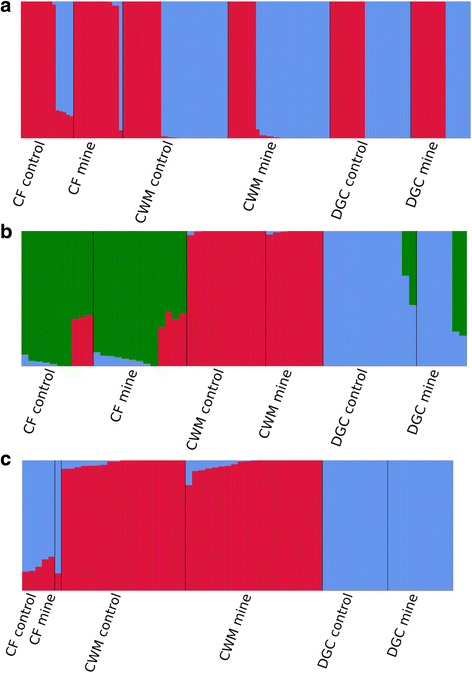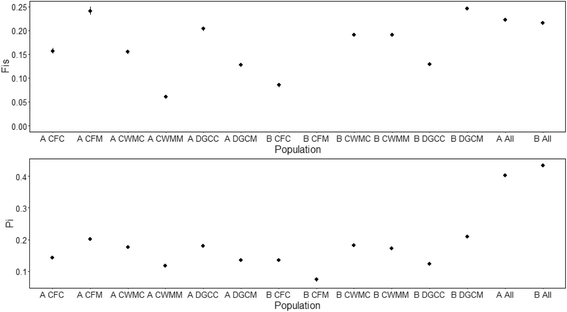Genetic variation in populations of the earthworm, Lumbricus rubellus, across contaminated mine sites
- PMID: 29149838
- PMCID: PMC5693503
- DOI: 10.1186/s12863-017-0557-8
Genetic variation in populations of the earthworm, Lumbricus rubellus, across contaminated mine sites
Abstract
Background: Populations of the earthworm, Lumbricus rubellus, are commonly found across highly contaminated former mine sites and are considered to have under-gone selection for mitigating metal toxicity. Comparison of adapted populations with those found on less contaminated soils can provide insights into ecological processes that demonstrate the long-term effects of soil contamination. Contemporary sequencing methods allow for portrayal of demographic inferences and highlight genetic variation indicative of selection at specific genes. Furthermore, the occurrence of L. rubellus lineages across the UK allows for inferences of mechanisms associated with drivers of speciation and local adaptation.
Results: Using RADseq, we were able to define population structure between the two lineages through the use of draft genomes for each, demonstrating an absence of admixture between lineages and that populations over extensive geographic distances form discrete populations. Between the two British lineages, we were able to provide evidence for selection near to genes associated with epigenetic and morphological functions, as well as near a gene encoding a pheromone. Earthworms inhabiting highly contaminated soils bare close genomic resemblance to those from proximal control soils. We were able to define a number of SNPs that largely segregate populations and are indicative of genes that are likely under selection for managing metal toxicity. This includes calcium and phosphate-handling mechanisms linked to lead and arsenic contaminants, respectively, while we also observed evidence for glutathione-related mechanisms, including metallothionein, across multiple populations. Population genomic end points demonstrate no consistent reduction in nucleotide diversity, or increase in inbreeding coefficient, relative to history of exposure.
Conclusions: Though we can clearly define lineage membership using genomic markers, as well as population structure between geographic localities, it is difficult to resolve markers that segregate entirely between populations in response to soil metal concentrations. This may represent a highly variable series of traits in response to the heterogenous nature of the soil environment, but ultimately demonstrates the maintenance of lineage-specific genetic variation among local populations. L. rubellus appears to provide an exemplary system for exploring drivers for speciation, with a continuum of lineages coexisting across continental Europe, while distinct lineages exist in isolation throughout the UK.
Keywords: Adaptation; Arsenic; Earthworms; Ecotoxicology; Lead; Population genomics; RADseq.
Conflict of interest statement
Ethics approval
Permission was not required for sampling of earthworms, as these are unmanaged and abandoned industrial land;
Consent for publication
Not applicable.
Competing interests
The authors declare no financial or non-financial competing interests.
Publisher’s Note
Springer Nature remains neutral with regard to jurisdictional claims in published maps and institutional affiliations.
Figures




Similar articles
-
Deeply divergent sympatric mitochondrial lineages of the earthworm Lumbricus rubellus are not reproductively isolated.BMC Evol Biol. 2015 Oct 5;15:217. doi: 10.1186/s12862-015-0488-9. BMC Evol Biol. 2015. PMID: 26438011 Free PMC article.
-
Resistance to copper toxicity in populations of the earthworms Lumbricus rubellus and Dendrodrilus rubidus from contaminated mine wastes.Environ Toxicol Chem. 2001 Oct;20(10):2336-41. doi: 10.1897/1551-5028(2001)020<2336:rtctip>2.0.co;2. Environ Toxicol Chem. 2001. PMID: 11596768
-
Impact of the earthworm Lumbricus terrestris (L.) on As, Cu, Pb and Zn mobility and speciation in contaminated soils.Environ Pollut. 2011 Mar;159(3):742-8. doi: 10.1016/j.envpol.2010.11.033. Epub 2010 Dec 24. Environ Pollut. 2011. PMID: 21185630
-
Arsenic speciation in the earthworms Lumbricus rubellus and Dendrodrilus rubidus.Environ Toxicol Chem. 2003 Jun;22(6):1302-8. Environ Toxicol Chem. 2003. PMID: 12785588
-
Interactions between earthworms and arsenic in the soil environment: a review.Environ Pollut. 2003;124(3):361-73. doi: 10.1016/s0269-7491(03)00047-2. Environ Pollut. 2003. PMID: 12758017 Review.
Cited by
-
Polymorphic microsatellite markers demonstrate hybridization and interspecific gene flow between lumbricid earthworm species, Eisenia andrei and E. fetida.PLoS One. 2022 Feb 18;17(2):e0262493. doi: 10.1371/journal.pone.0262493. eCollection 2022. PLoS One. 2022. PMID: 35180227 Free PMC article.
-
The Effects of In Vivo Exposure to Copper Oxide Nanoparticles on the Gut Microbiome, Host Immunity, and Susceptibility to a Bacterial Infection in Earthworms.Nanomaterials (Basel). 2020 Jul 9;10(7):1337. doi: 10.3390/nano10071337. Nanomaterials (Basel). 2020. PMID: 32659907 Free PMC article.
References
-
- Walker CH, Sibly RM, Hopkin SP, Peakall DB. Principles of Ecotoxicology, Fourth Edition [Internet]. CRC Press; 2012 [cited 2016 Apr 14]. Available from: https://books.google.com/books?id=sk3OBQAAQBAJ&pgis=1
-
- Connell DW, Lam P, Richardson B, Wu R. Introduction to Ecotoxicology [Internet]. John Wiley & Sons; 2009 [cited 2016 Apr 14]. Available from: https://books.google.com/books?hl=en&lr=&id=n7lLTzD6PHYC&pgis=1
-
- Kooijman SALM, Bedaux JJM. Analysis of toxicity tests on Daphnia survival and reproduction. Water Res. [Internet]. 1996 [cited 2016 Apr 14];30:1711–23. Available from: http://www.sciencedirect.com/science/article/pii/0043135496000541
-
- Hanson N, Stark JD. Comparison of population level and individual level endpoints to evaluate ecological risk of chemicals. Environ. Sci. Technol. [Internet]. American Chemical Society; 2012 [cited 2016 May 10];46:5590–5598. Available from: doi: 10.1021/es3008968 - PubMed
-
- Segner H. Moving beyond a descriptive aquatic toxicology: the value of biological process and trait information. Aquat. Toxicol. [Internet]. 2011 [cited 2016 May 10];105:50–55. Available from: http://www.sciencedirect.com/science/article/pii/S0166445X11001858 - PubMed
MeSH terms
Substances
Grants and funding
LinkOut - more resources
Full Text Sources
Other Literature Sources

